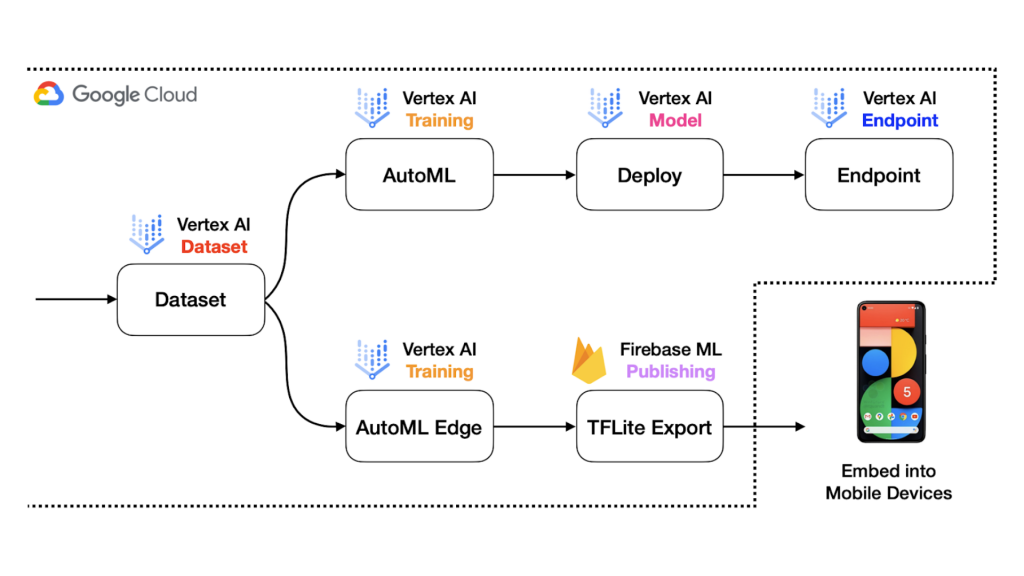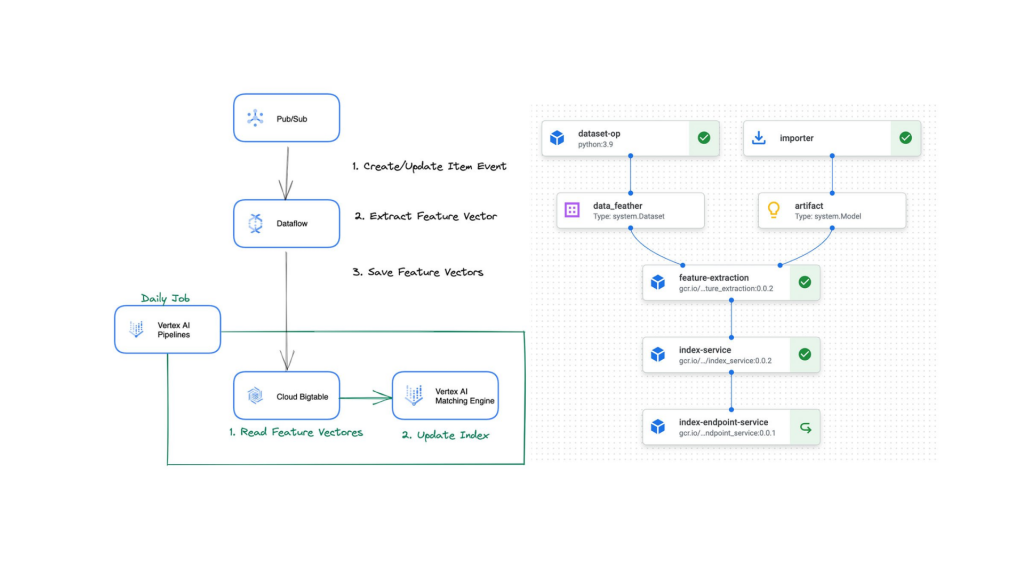Are you having trouble improving your AI projects? Vertex AI can help you tackle these challenges with its powerful tools. Vertex AI offers solutions that make it easier to train and deploy AI models.
In this article, we will explore the latest innovations in Vertex AI that simplify the process of working with AI. You’ll learn about features that save time and improve your results. Read on to discover key insights that can transform the way you manage your AI projects and help you achieve your goals more effectively.
Key Takeaways
- Vertex AI offers tools like Gemini API and AutoML to make AI projects easier, even for beginners. It works with Google Cloud to keep data safe.
- You can use generative AI in Vertex AI for tasks like summarizing articles, classifying images, and making smart predictions without needing deep learning skills.
- Data security is a top priority with enterprise-grade governance and secure model training features ensuring project safety from start to end.
- Batch and real-time predictions allow businesses to process large data sets or get instant analytics, helping make quicker decisions based on the latest information.
Innovations in Generative AI
Generative AI is changing the game, making it simple to train and use large models for creative tasks like writing summaries or recognizing images. With tools like Vertex AI, users can tap into this power for a range of projects—no deep-learning expertise is needed.
Training and deploying large Generative AI models
Large generative AI models take lots of data and learn from it. Google’s Vertex AI lets you train these big models without being an expert. It handles massive amounts of data and can grow to meet your needs.
You spend less time setting things up and more time creating with AI.
Vertex AI also makes putting your model to work easy, whether in the cloud or on IoT devices. You get tools for batch predictions or real-time responses. This means businesses can use AI for smarter decisions faster, like understanding customer feelings or suggesting products online.
Using Generative AI for summarization, classification, and extraction
Generative AI makes it easy to summarize texts, classify images, and pull out important details. This technology offers great tools for tech projects.
- Summarizing long articles quickly with generative AI. It reads the whole thing and gives you a short version.
- Classifying photos into groups like animals, cars, or food without manual sorting. The AI learns what each thing looks like and does it for you.
- Pulling key info from documents. Say you have lots of emails or reports; generative AI finds the parts you need.
- Making sense of big data sets in research or e-commerce platforms. This helps see trends or make predictions.
- Helping with language tasks like translating text or understanding customer feedback for digital transformation.
- Improving online predictions for things like shopping recommendations by learning what customers like.
- Enhancing data analytics by spotting patterns in data faster than humans can.
- Automating routine tasks in big data analytics, saving time and cutting mistakes.
These uses show how generative AI is changing tech work by doing things faster and smarter than before.
Overview of Vertex AI
Vertex AI brings tools and models, like Gemini API and machine learning solutions, right to your fingertips. It links up with everything you need from start to finish in machine learning projects.

Access to Gemini models via the Gemini API
The Gemini API opens up a world of AI possibilities. It connects you to Google Gemini and PaLM 2 models, like Text & Chat Bison. These tools are great for jobs that need fast answers or translation.
You get to use advanced AI without being an expert in machine learning (ML) or natural language processing.
Using the API is simple and boosts your projects with AI-powered features. Whether it’s making smart chatbots or translating text quickly, the Gemini models help a lot. They make sure your applications respond fast and understand many languages.
Integration with end-to-end ML tools
Vertex AI works well with full ML toolsets. It allows data scientists to use AutoML and TensorFlow for various data types, like images and text. This means they can make custom models easily.
They don’t need much expertise in machine learning.
For example, users connect Vertex AI with tools for managing data analysis, like BigQuery, and ML operations platforms such as Kubeflow. These connections help teams manage their whole ML workflow in one place.
They can train models faster and more accurately by using features from Vertex AI, like hyperparameter tuning and model garden access.
Key Features of Vertex AI
Vertex AI stands out with its powerful features. It offers Gemini models for advanced tasks and MLOps to manage both predictive and creative art projects, making machine learning easy for all skill levels.

Enterprise-ready AI with Gemini models
Gemini models in Vertex AI make your AI projects ready for big jobs. They work with Google Gemini and PaLM 2 models. This means you can count on these tools to handle lots of data fast and well.
You get strong AI that scales up as needed, perfect for businesses.
These models help with tasks like forecasting, online courses, and making web tools smarter. With minimal setup, they let beginners do advanced things. For security, everything runs on Google Cloud.
This keeps your data safe while your projects grow.
MLOps for predictive and generative AI
MLOps makes AI work fast and safe. It uses tools like Vertex AI Workbench and Pipelines. This lets people build machine learning models without much trouble. They can make models that guess or create new things.
For example, they could predict what customers will buy next.
Companies use MLOps to get their AI projects running smoothly. It helps them train, test, and deploy models all in one place. So, if a store wants to know what toys will be popular for Christmas, MLOps can help find the answer quickly.
This way of working with AI saves time and money for businesses.
Customizable ML training with minimal expertise
Custom training lets you use popular machine learning frameworks like PyTorch and TensorFlow. This means even if you’re new to machine learning, you can still build powerful models.
With AutoML, the process gets simpler. You don’t need to write code or prepare data yourself. It’s all automated. This makes it easy for anyone to start with AI.
Deploying AI Models with Vertex AI
Putting your AI models to work is easy with Vertex AI. You can choose between batch or real-time predictions, fitting any project needs.

Batch or online predictions
Vertex AI supports batch and online predictions. This feature allows models to analyze lots of data at once or respond instantly. Users get real-time analytics with online predictions.
They make instant decisions based on fresh information. Batch predictions process big data sets all together. This is great for when you have a lot of info but no rush.
With Vertex AI, choose how you predict: in batches or in real time.
Both ways help businesses use cloud services for predictive analysis. Online predictions suit live data like customer actions on a website. Batch predictions are good for daily summaries from huge amounts of info.
With these options, companies can better understand data and make smart choices fast.
Vertex AI custom quote and pricing calculator for deployment
The custom quote and pricing calculator for deployment on Google Cloud Vertex AI makes project costs clear. It fits a pay-as-you-use model, keeping budgets in check. Users enter details about their AI projects, like size and complexity.
The tool then gives an exact cost estimate. This means no surprises in spending.
This calculator supports various services—batch predictions, online predictions, data science tasks, and machine learning techniques. It helps users pick what they need while showing the price tag upfront.
So, managing resources becomes simpler and more efficient for every project stage.
Data Management and Security in Vertex AI
Data safety and control get a big boost with Vertex AI. New tools make sure your data stays safe and meets strict rules, making it easier to manage and protect.
Enterprise-grade data governance
Enterprise-grade data governance ensures top security for AI projects. This means strict rules protect all data. Encryption and access controls keep information safe. These measures work together to guard against unauthorized use or leaks.
Vertex AI uses these strong policies. It gives users control over their cloud-based, machine-learning projects with confidence. Data stays secure from start to finish, whether in training or deploying models.
Secure model training and deployment
Vertex AI makes sure your model training and deployment follow strict rules. It meets global data privacy laws. This means all steps comply with needed safety measures. Your data is safe from start to finish.
It uses tools like Feature Store and MLOps to keep everything secure. These tools help manage and protect your models in the cloud or on-premises setups. So, you can trust that your AI projects are both powerful and protected at every step.
Getting Started with Vertex AI
Jumping into working with Vertex AI is easy and rewarding. You get up to $300 in free credits, making it simple to begin creating with machine learning on this platform.

Up to $300 in free credits for new customers
New customers get a big boost with up to $300 in free credits. These credits help lower the starting costs of using machine learning projects on Vertex AI. This makes it easier for users to try out powerful tools like generative AI studios and ML algorithms without worrying about the initial expense.
You can use these credits across various services, including data mining, predictive analytics, and more. With this incentive, setting up your first project gets less costly, encouraging more people to explore artificial intelligence’s possibilities.
Easy setup of Vertex AI project environment
Setting up a Vertex AI project environment is straightforward and quick. Users start by logging into their Google Cloud account. Then, they create a new project or select an existing one.
Next, they enable the Vertex AI and associated APIs like Compute Engine and Cloud Storage. This process takes only a few minutes.
Users also find resources for all levels, making it easier to learn as they go. Guides cover everything from starting a new project to deploying machine learning models. For example, users can follow tutorials on how to use Colab Enterprise for experimenting with models or how to scale their applications using hybrid cloud features.
Beginners and experts alike can get their AI projects up and running fast with Vertex AI’s user-friendly setup.
Conclusion
Vertex AI strengthens your AI projects by making it easy to train, deploy, and manage large, intelligent models. With its user-friendly setup, Vertex AI helps you work faster and with more confidence, even when handling complex tasks. It also prioritizes data security, keeping your information safe as you innovate and develop new solutions. This powerful tool allows you to focus on creativity and results, removing many common technical challenges.
Overall, choosing Vertex AI means achieving more impact, streamlining your AI efforts, and delivering stronger, smarter solutions with peace of mind.
(Image Source: Google Cloud)
Frequently Asked Questions
1. What is Vertex AI?
Vertex AI refers to advancements in artificial intelligence (AI) and machine learning algorithms used on cloud platforms. They provide scalable solutions for projects involving sentiment analysis, image recognition, recommendation systems, and more.
2. How can Vertex AI empower my AI projects?
Vertex AI empowers your projects by providing tools like Llama 3.1 and Llama 2 for large language models… It offers scalability that allows you to scale horizontally as needed… Plus, it includes foundation models for prototyping and provisioning in the development environment.
3. Can I use Vertex AI for image or video recognition?
Yes! Along with text-based applications such as sentiment analysis or voice assistants… Vertex Ai’s imagen tool is designed specifically for tasks like image classification—making it a great choice for image and video recognition!
4. Does Vertex AI offer automation features?
Absolutely! With event-driven capabilities, streaming data processing, and automated visualizations—it’s all about improving efficiency… And don’t forget—the best practices of automation also contribute to creating better customer experiences.
5. How does explainability fit into the picture with Vertex AI?
Explainability is key in understanding how your machine learning model works… In other words—it’s about making sense of the “why” behind your model’s decisions… This feature helps build trust in your system while ensuring adherence to ethical standards…
6. Are there any limitations when using Azure Machine Learning alongside Vertex AI pipelines?
No limitations per se—both Azure Machine Learning and vertex ai pipelines are designed to work seamlessly together… They both support creativity within an artificial intelligence framework while maintaining high standards of performance.





